使用者:Huyukui/沙盒
孔雀王朝 | |||||||||||||||||||||
|---|---|---|---|---|---|---|---|---|---|---|---|---|---|---|---|---|---|---|---|---|---|
| 前322年—前184年 | |||||||||||||||||||||
![歷史學家文森特·阿瑟·史密斯(英語:Vincent Arthur Smith)[1]、R·C·馬宗達(英語:R. C. Majumdar)[2]和歷史地理學家約瑟夫·E·施瓦茨貝里(英語:Joseph E. Schwartzberg)[3]根據阿育王碑文中的位置信息繪製的孔雀帝國最大疆域範圍](http://upload.wikimedia.org/wikipedia/commons/thumb/2/2c/Maurya_Empire%2C_c.250_BCE_2.png/250px-Maurya_Empire%2C_c.250_BCE_2.png) | |||||||||||||||||||||
![一些學者在他們的著作中,將孔雀帝國的國土概念化成「被大自治區們分割成的線狀網絡」。例如歷史學家赫爾曼·庫爾克(英語:Hermann Kulke)和迪特瑪爾·羅特蒙特(英語:Dietmar Rothermund);[4]波頓·斯坦因(英語:Burton Stein);[5]大衛·盧登;[6]和羅米拉·塔帕(英語:Romila Thapar);[7]人類學家莫妮卡·L·史密斯(英語:Monica L. Smith)[8]和斯坦利·譚拜爾(英語:Stanley Tambiah);[7]考古學家羅賓·科寧漢(英語:Robin Coningham);[7]和歷史人口學家蒂姆·戴森(英語:Tim Dyson)。[9]](http://upload.wikimedia.org/wikipedia/commons/thumb/c/c4/Maurya_Empire%2C_c.250_BCE.png/250px-Maurya_Empire%2C_c.250_BCE.png) | |||||||||||||||||||||
| 首都 | 巴塔利普特拉(今比哈爾邦巴特那) | ||||||||||||||||||||
| 常用語言 | 摩揭陀俗語 | ||||||||||||||||||||
| 宗教 | |||||||||||||||||||||
| 政府 | 君主專制(考底利耶所著政事論及羅闍曼荼羅[18]) | ||||||||||||||||||||
| 皇帝 | |||||||||||||||||||||
• 前322年–前298年 | 旃陀羅笈多 | ||||||||||||||||||||
• 前298年–前272年 | 賓頭娑羅 | ||||||||||||||||||||
• 前268年–前232年 | 阿輸迦(阿育王) | ||||||||||||||||||||
• 前232年–前224年 | 達沙拉沙 | ||||||||||||||||||||
• 前224年–前215年 | 三缽羅底 | ||||||||||||||||||||
• 前215年–前202年 | 舍利輸迦 | ||||||||||||||||||||
• 前202年–前195年 | 提婆伐摩 | ||||||||||||||||||||
• 前195年–前187年 | 薩塔陀拉 | ||||||||||||||||||||
• 前187年–前184年 | 布柯陀羅多(巨車王) | ||||||||||||||||||||
| 歷史時期 | 鐵器時代 | ||||||||||||||||||||
• 征服難陀帝國 | 前322年 | ||||||||||||||||||||
• 弗沙蜜多羅·巽伽刺殺布柯陀羅多(巨車王) | 前184年 | ||||||||||||||||||||
| 面積 | |||||||||||||||||||||
• 總計 | 5,500,000平方公里 | ||||||||||||||||||||
| 前261年[19] | 3,400,000平方公里 | ||||||||||||||||||||
| 前250年[20] | 5,500,000平方公里 | ||||||||||||||||||||
| 貨幣 | 帕那 | ||||||||||||||||||||
| |||||||||||||||||||||
| 今屬於 | |||||||||||||||||||||
| 孔雀帝國 (前322年–前180年) | ||||||||||||||||||||
|---|---|---|---|---|---|---|---|---|---|---|---|---|---|---|---|---|---|---|---|---|
|
||||||||||||||||||||
孔雀帝國是南亞次大陸上建立於鐵器時代的地域廣袤的強大政權,由旃陀羅笈多於公元前322年,以摩揭陀國為基礎建立,一直延續到公元前185年。[21]孔雀帝國征服了印度河-恆河平原,並以其為中心,首都位於巴塔利普特拉(今巴特那)。在帝國中心之外,帝國的疆域取決於控制各城市的軍隊將領的忠誠度。[22][23][24] 在阿育王統治期間(約公元前268年-公元前232年),帝國控制了除最南南部以外的印度次大陸的主要城市樞紐和動脈。[21]它在阿育王統治後大約50年開始衰落,在公元前185年因弗沙蜜多羅·巽伽暗殺了布柯陀羅多,並在摩揭陀建立巽伽王朝而滅亡。
旃陀羅笈多·孔雀在政事論的作者考底利耶[25]的協助下組建了一支軍隊,並於約公元前322年推翻了難陀帝國。旃陀羅笈多擊敗了亞歷山大大帝留下的總督們,迅速將他的勢力向西擴展到印度中西部,到公元前317年,帝國完全占領了印度西北部。[26] 孔雀帝國隨後在塞琉古-孔雀戰爭期間擊敗了塞琉古帝國的建立者和繼業者塞琉古一世,從而獲得了印度河以西的領土。[27][28]
在孔雀王朝時期,由於建立了一個單一而有效的金融、行政和安全體系,內部和外部的貿易、農業和經濟活動在整個南亞得到了蓬勃的發展。孔雀王朝修建了從巴塔利普特拉到塔克西拉部分的大幹道的前身。[29]羯陵伽戰爭後,帝國在阿育王的統治下經歷了近半個世紀的中央集權統治。阿育王對佛教的信仰和對佛教傳播的贊助佛教信仰擴展到斯里蘭卡、印度西北部和中亞地區。[30]
孔雀王朝時期的南亞人口估計在1500萬到3000萬之間。[31] 帝國統治時期在藝術、建築和碑刻等方面的取得了非凡的成就,[32]但與此同時,恆河平原的種姓制度得以鞏固,另外印度-雅利安語支地區的婦女地位普遍下降。[33] 從考古學上看,孔雀王朝的統治時期南亞正處於北方磨光黑陶文化(NBPW)時代。政事論[34]和阿育王詔書是孔雀王朝時代的主要文獻資料。鹿野苑的阿育王石柱柱頭是印度共和國的國徽。
名稱來源
[編輯]「Maurya(孔雀)」這個名字沒有出現在阿育王碑文中,也沒有出現在諸如麥加斯梯尼的印度史等同時代的希臘記述中,但有以下資料證明:[35]
- 樓陀羅達曼的朱納格岩刻頌德文(約公元150年)中,在旃陀羅笈多和阿育王的名字前加上了「Maurya(孔雀)」的前綴。[35]
- 往世書(約公元4世紀或更早)使用Maurya(孔雀)作為王朝稱謂。[35]
- 佛教文獻指出,旃陀羅笈多屬於釋迦族的「Moriya」氏族,是釋迦牟尼所屬的部落。[35]
- 耆那教的文本指出,旃陀羅笈多是一位皇家孔雀主管(mayura-poshaka) 的兒子。[35]
- 泰米爾桑加姆文學也將它們稱呼為「moriyar」,提及他們既難陀人之後統治印度[36]
- 公元12世紀的孔塔拉碑文(來自北邁索爾的班達尼克鎮)按時間順序提到「Mauryya」是統治該地區的朝代之一。[37]
根據一些學者的說法,迦羅衛羅的訶提袞帕石刻(公元前2世紀至公元前1世紀)將孔雀帝國的時代稱為「Muriya Kala」(孔雀時代),[38]但這種解讀存在爭議:其他學者,例如碑銘研究家D·C·薩卡爾將這句話解讀為"mukhiya-kala(「主要藝術」)。[39]
根據佛教傳說,王朝王室的祖先曾定居在孔雀(巴利語中稱為mora)聚集的地區。因此,他們被稱為「Moriyas」,字面意思是「來自孔雀之地」。另據佛教文獻記載,王室的祖先們建造了一座名為「Moriya-nagara」(孔雀之城)的城市,之所以得名,是因為它是用「像孔雀脖子一樣顏色的磚塊」建造的。[40]
正如佛教和耆那教傳說中提到的那樣,王朝與孔雀的聯繫似乎得到了考古證據的證實。例如,在南丹加爾的阿育王柱上發現了孔雀雕像,以及在桑吉大佛塔內發現了幾座孔雀雕塑。基於這些證據,現代學者推測孔雀可能是該王朝的象徵。[41]
還有一些作者,例如杜底拉奇(一位曼陀羅克夏沙的點評人)和一位毗濕奴往世書的注釋者,聲稱「Maurya」這個詞源自"Mura",是第一位孔雀王的母親。然而,往世書本身並沒有提到"Mura",也沒有提及難陀王朝和孔雀王朝之間的任何聯繫。[42]杜底拉奇對這個詞的派生似乎是他自己的發明:根據梵文規則,女性名字Mura(IAST:Murā)的派生詞是「Maureya」;「Maurya」一詞只能來自男性的「Mura」。[43]
歷史
[編輯]建立
[編輯]在孔雀帝國之前,難佗帝國統治着印度次大陸的大部分地區。通過對印度列國的征服,難陀帝國成為一個地域廣大、軍力強盛的、經濟繁榮的帝國。據傳說,考底利耶前往難佗帝國首都摩揭陀的巴塔利普特拉,並在那裡成為帝國的大臣。然而,考底利耶受到難陀王朝的皇帝達那·難陀的侮辱,考底利耶發誓報仇,要摧毀難陀帝國。[44]為了保住性命,他不得不逃到著名的學術中心塔克西拉當教師。在一次旅行途中,考底利耶目睹了一隊年輕人在玩戰爭遊戲。其中,年輕的旃陀羅笈多給他留下了深刻的印象,認為在他身上發現的資質,使得他有可能成為一個合格的統治者。
與此同時,亞歷山大大帝正在帶領他的軍隊攻進旁遮普地區。他的軍隊在比亞斯河與另一隻軍隊進行了激戰後,爆發了叛亂,拒絕進一步向東推進。亞歷山大回到巴比倫,將他的大部分部隊重新部署在印度河以西。亞歷山大於公元前323年在巴比倫去世,不久後,他的帝國分裂為由他的將軍們領導的若干獨立王國。[45]
孔雀帝國由旃陀羅笈多和其導師考底利耶在摩揭陀地區建立。考底利耶將旃陀羅笈多帶到了塔克西拉,並傳授他治國之道。旃陀羅笈多招募軍隊,吞併了一些當地的軍事共和國,例如曾經抵抗亞歷山大帝國的游得希亞。孔雀軍隊迅速崛起,成為印度次大陸西北部主要的地方勢力。孔雀軍隊隨後擊敗了馬其頓人建立的總督政權。[46]古希臘歷史學家尼阿庫斯、阿尼西里烏斯和阿里斯托布魯斯留下了大量的有關孔雀帝國的歷史資料。[47]當時希臘將軍歐德摩斯和培松統治着印度河流域,大約公元前317年,旃陀羅笈多·孔雀(在他的顧問考底利耶的幫助下)擊敗並驅逐了希臘總督,隨後將印度河流域置於他的摩揭陀政權的統治之下。[26]
旃陀羅笈多·孔雀的祖先籠罩在神秘和爭議之中。一方面,許多古印度文獻,例如維沙哈達塔的劇作曼陀羅克夏沙(羅克夏沙的印戒——羅克夏沙是摩揭陀的宰相)描述了他的皇室血統,甚至將他與難陀家族聯繫在一起。早期的佛教典籍《大般涅槃經》中則提到了一個被稱為孔雀家族的剎帝利氏族。然而,如果沒有進一步的歷史證據,任何論點都很難被證實。旃陀羅笈多在早期的希臘歷史記錄中,被稱為「山德羅克托斯」。據說他年輕時見過亞歷山大。[48]另外,傳說考底利耶見到過難陀國王,激怒了他,然後九死一生的逃了出來。[49]
征服難陀帝國
[編輯]關於旃陀羅笈多與難陀帝國之間的戰爭細節已不可考,而產生於幾個世紀後的那些歷史傳說也說法不一。佛教、耆那教和印度教的文獻稱當時摩揭陀由難陀王朝統治,在考底利耶的輔佐下,旃陀羅笈多征服了難陀帝國。[51][52][53]旃陀羅笈多和考底利耶的軍隊首先占領了難陀的外圍領土,最後圍攻難陀首都巴塔利普特拉。在佛教的典籍中,孔雀王朝很輕鬆的就取得了戰役的勝利,但在印度教和耆那教文獻中,由於難陀王朝擁有一支強大且訓練有素的軍隊,整場戰役進行的非常激烈。[54][52]
佛教典籍《大史》和耆那教典籍《附錄》記載了旃陀羅笈多軍隊襲擊難陀首都的失敗。[55]旃陀羅笈多和考底利耶隨即調整了策略,從難佗帝國的邊境開始逐步蠶食,占領了難陀首都周邊的領土。[56]然後,他們在占領地上部署駐軍鞏固統治,並最終圍困了難陀首都巴塔利普特拉。達那·難陀最終失敗,[57][58]這次戰役在劇本曼陀羅克夏沙中進行了戲劇化,加了一些其他版本的考底利耶-旃陀羅笈多傳說中沒有的情節。由於這些差異,托馬斯·施特勞曼認為曼陀羅克夏沙中大部分的內容是虛構的,或僅僅只是傳說,沒有任何歷史依據。[59]拉妲·庫穆德·穆克吉同樣認為曼陀羅克夏沙的內容缺乏歷史依據。[60]
有些傳說稱難陀國王被打敗、廢黜並流放,而佛教的文獻則聲稱他被殺害了。[61]隨着難陀的失敗,旃陀羅笈多·孔雀建立了孔雀帝國。[62]
旃陀羅笈多·孔雀
[編輯]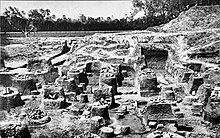

公元前323年亞歷山大大帝之死後,旃陀羅笈多於公元前305年發動了一系列戰役,占領了印度河流域和印度西北部的一系列總督區。[63]亞歷山大的剩餘部隊被擊潰後,向西退卻,同時塞琉古一世(勝利者)帶領其屬下部隊奮力保衛這些領土。歷史資料中關於這場戰役的細節記載並不多。最終塞琉古也被擊敗,並帶領部隊撤退到阿富汗山區。[64]
兩位統治者於公元前303年締結了和平條約並聯姻。根據合約條款,旃陀羅笈多得到了帕羅帕密薩代(劍浮沙和健馱邏)和阿拉霍西亞(坎大哈)和格德羅西亞(俾路支斯坦)等三個總督區。塞琉古一世得到了500頭戰象,這些戰象日後在公元前301年的伊普蘇斯戰役中,為戰勝西方希臘化國王聯軍發揮了決定性作用。建立了外交關係後,一些希臘人,如歷史學家麥加斯梯尼、德伊馬科斯和狄奧尼西奧斯留在了孔雀王朝的宮廷。[65]
麥加斯梯尼是旃陀羅笈多·孔雀宮廷中著名的希臘大使。[66] 根據阿里安的說法,麥加斯梯尼大使(約公元前350年至公元前290年)住在阿拉霍西亞,並經常前往巴塔利普特拉。[67]麥加斯梯尼將孔雀帝國的社會描述成一個熱愛自由的社會,這打消了塞琉古入侵孔雀帝國的想法,當然,塞琉古做出決定的底層原因是,入侵成功的可能性也比較低。之後的幾年裡,塞琉古的繼任者們根據歸國旅行者的類似敘述,繼續與孔雀帝國保持良好的外交關係。[63]
旃陀羅笈多在巴塔利普特拉建立了一個強大的中央集權國家,據麥加斯梯尼稱,該城「擁有64座門和570座的木城牆所包圍」。埃里亞努斯雖然沒有明確引用麥加斯梯尼的描述也沒有提到巴塔利普特拉,但他將印度的宮殿描述為「比波斯在蘇薩或埃克巴坦那的皇宮更加富麗堂皇」。[68]這座城市的建築風格似乎與當時的波斯城市建築風格有許多相似之處。[69]
旃陀羅笈多的兒子賓頭娑羅將孔雀帝國的統治擴展到印度南部。桑加姆文學中著名的泰米爾泰米爾詩人馬穆納爾描述了德干高原以南的泰米爾國家是如何被由卡納塔克人組成的孔雀帝國軍隊征服的。馬穆拉納爾指出,瓦杜加爾人(居住在緊鄰泰米爾納德北部的安得拉-卡納塔克地區)構成了孔雀王朝軍隊的先鋒。[36][70]旃陀羅笈多的宮廷里還有一位希臘大使,名叫德伊馬科斯。[71]按照普魯塔克的說法,旃陀羅笈多·孔雀征服了整個印度,而按照查士丁的說法,旃陀羅笈多·孔雀「擁有印度」。這些說法得到了泰米爾桑加姆文獻的證實,其中提到孔雀王朝與他們的南印度盟友的入侵,以及在今泰米爾納德邦蒂魯內爾維利地區的波迪伊爾山擊敗他們的敵人。[72][73]
而後,旃陀羅笈多放棄了王位,跟隨他的耆那教老師巴德拉巴胡皈依了耆那教。[74][75][76]據傳說,他先是在什拉瓦納貝拉戈拉做了幾年苦行僧,然後依據耆那教的薩萊克哈那儀式,絕食而死。[77]
賓頭娑羅
[編輯]
賓頭娑羅是孔雀帝國建立者旃陀羅笈多的兒子。這件事被若干《往世書》和《大史》等材料的證明。[78]其本人的存在也被一些佛教經典例如《島史》和《大史》(「Bindusaro」),耆那教經典例如《附錄》以及印度教經典例如《毗濕奴往世書》("Vindusara")等所證明。[79][80]根據12世紀耆那教作家金月的附錄記載,賓頭娑羅的母親的名字是杜達羅。[81]一些希臘的文獻資料,提到他的時候,稱他為「阿米托羅剎斯特」或其變體。[82][83]
歷史學家烏平德·辛格估計賓頭娑羅於公元前297年左右登上王位。[70]年僅22歲的賓頭娑羅繼承了一個龐大的帝國,該帝國由現在的印度北部、中部和東部地區以及阿富汗和俾路支斯坦的部分地區組成。賓頭娑羅將帝國版圖擴張到了印度南部,最南端到達了今天的卡納塔克邦的地區。他將十六大國征服,占據幾乎整個印度半島(據說他還征服了「兩海之間的土地」——孟加拉灣和阿拉伯海之間的半島地區)。賓頭娑羅沒有征服那些友好的泰米爾王國,包括伊拉姆切琴尼治下的朱羅王國,潘地亞王國和哲羅王國。除了這些南部國家,羯陵伽國(今天的奧里薩邦)是印度唯一一個沒有被納入賓頭娑羅帝國的王國。[84]羯陵伽國後來被賓頭娑羅的兒子阿育王征服,阿育王在父親統治期間擔任鄔闍衍那的總督,這凸顯了鄔闍衍那的在孔雀帝國中的重要性。[85][86]
賓頭娑羅和他的父親旃陀羅笈多以及他的兒子阿育王一樣,生平並沒有被記錄下來。考底利耶繼續擔任首相。據曾經訪問過印度的中世紀西藏學者多羅那他的描述,考底利耶幫助賓頭娑羅「消滅了十六大國的國王和貴族,成為了東西海之間領土的絕對主宰」。[87]在他的統治期間,塔克西拉人兩次起義。第一次叛亂源於他的長子修私摩管理不善。第二次叛亂的原因不明,並且賓頭娑羅生前並沒有將這次叛亂鎮壓下去。直到賓頭娑羅死後,這次叛亂才被阿育王粉碎。[88]
賓頭娑羅與希臘世界一直保持着友好的外交關係。德伊馬科斯是塞琉古皇帝安條克一世在賓杜薩拉宮廷的大使。[89]據狄奧多羅斯的記載,巴塔利普特拉的國王(孔雀王朝的首都巴塔利普特拉)曾經熱情款待過一位希臘的作家亞姆布魯斯。這位國王通常被認為就是賓頭娑羅。[89]另外據普林尼記載,埃及國王愛手足者也曾經派過一位名叫狄奧尼西奧斯的使者前往印度。[90][91]根據夏連特拉·納特·塞恩的說法,這件事似乎發生在賓頭娑羅的統治時期。[89]
與他的父親旃陀羅笈多(後來改信耆那教)不同,賓頭娑羅信奉正命論教派。賓頭娑羅的上師平加爾瓦察(賈納賈納)是一位正命論教派的婆羅門。[92]賓頭娑羅的妻子,蘇巴讓吉王后(達摩王后/阿加馬赫西往後)同樣是一位來自占普里(今天的巴加爾布爾)的信奉正命論教派的婆羅門。[93]賓頭娑羅因向婆羅門寺院提供多項資助而備受讚譽,被稱為婆羅門信徒(Brahmana-bhatto)。[94]
歷史證據表明,賓頭娑羅死於公元前270年代。根據烏平德·辛格的說法,賓頭娑羅死於公元前273年左右。[70]阿蘭·丹尼羅則認為他死於公元前274年左右。[87]夏連特拉·納特·塞恩認為他在公元前273年至272年左右去世,他死後,孔雀王朝經歷了四年的繼承權鬥爭,之後他的兒子阿育王在公元前269年至268年左後成為皇帝。[89]根據《大史》的說法,賓頭娑羅在位28年。[95]而在伐由往世書中,旃陀羅笈多的繼任者名叫「Bhadrasara」,統治了25年。[96]
阿育王
[編輯]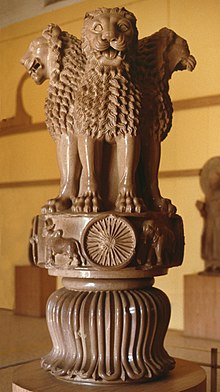

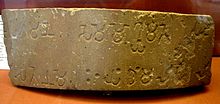
作為年輕的王子,阿育王(公元前272-公元前232年在位)是一位出色的指揮官,他鎮壓了鄔闍衍那和塔克西拉的叛亂。作為君主,他雄心勃勃,氣勢逼人,重新確立了帝國在印度南部和西部的優勢。他對羯陵伽的征服(公元前262-公元前261年)是他一生中最重要的事件。阿育王在羯陵伽建造要塞並部署兵力防禦,以此來威懾周邊大片區域。[97]阿育王的軍隊成功地擊敗了羯陵伽的官軍和民兵,估計有100000名士兵和平民在殘酷的戰爭中喪生,其中包括10000多名阿育王自己的軍隊。數十萬人受到戰爭的波及。阿育王親眼目睹這場災難,開始感到懊悔。完成了對羯陵伽的吞併後,阿育王接受了佛教的教義,放棄了戰爭和暴力。他派傳教士週遊亞洲,將佛教傳播到其他國家。
為了遵循不害的原則,阿育王禁止了狩獵和暴育活動,結束了契約和強迫勞動(在飽受戰爭蹂躪的羯陵伽,有數千人被迫從事苦役和奴役)。阿育王一邊維持着龐大而強盛的軍隊,維護和平和權威,一邊擴大了與亞洲和歐洲各國的友好關係,並贊助了佛教傳播。他在全國範圍內開展了大規模的公共工程建設。40多年的和平、和諧與繁榮使阿育王成為印度歷史上最成功和最著名的君主之一。他現在仍然是印度理想化的人物。
刻在石頭上的阿育王詔書,遍及整個次大陸。西至阿富汗,南至安得拉(內洛爾區),阿育王的詔書闡述了他的政策和成就。詔書主要是用普拉克里特語書寫的,但其中有兩篇是用希臘語書寫的,一篇是用希臘語和阿拉姆語書寫的。阿育王詔書將希臘人、劍浮沙人和健馱邏人統稱為帝國邊境民族。詔書還記錄了阿育王曾派使者前往西方,最遠到達過地中海區域的希臘城邦。詔書還記述了當時希臘世界的統治者們都接收了阿育王的傳教,其中包括安條耶伽王(安條克)、托勒馬耶王(托勒密)、安提基那王(安提柯)、馬卡王(馬加斯)和亞歷基耶山大拉王(亞歷山大)。詔書還準確地定位了他們的領土「在600由旬之外」(1由甸約7英里),對應印度中部和希臘之間的距離(大約4,000英里)。[98]
衰敗
[編輯]阿育王之後的50年,孔雀王朝的繼任君主們都能力平平。阿育王的繼任者是他的孫子達沙拉沙·孔雀。阿育王的兒子中沒有一個可以登上皇位。他的長子摩哂陀一直在致力於傳播佛教。鳩那羅·孔雀是盲人因此無法登上皇位,卡魯瓦基的兒子帝瓦拉比阿育王更早去世。另一個兒子伽羅卡並沒有太多的記載。
帝國在達沙拉沙的統治下失去了許多領土,其本人的皇位也在隨後被鳩那羅的兒子三缽羅底奪取。在三缽羅底之後,孔雀王朝逐漸地失去了許多領土。公元前180年,布柯陀羅多·孔雀在閱兵中被他的將軍弗沙蜜多羅·巽伽刺殺,而布柯陀羅多並沒有繼承人。至此,偉大的孔雀帝國終於結束,巽伽帝國的興起。
造成帝國衰落的原因有很多,包括:阿育王的繼承者們普遍平庸;帝國被一分為二;帝國統治區域內的某些地區逐步實現了獨立,例如索法伽色努斯統治下的地區;權力完全掌握在少數人的手中,造成了政府的頭重腳輕;民族意識的缺失;[99]帝國的龐大造成了行政效率的低下;希臘-巴克特里亞王國的入侵。
一些歷史學家,如 H‧C‧雷喬杜里,認為阿育王的和平主義破壞了孔雀帝國的「尚武傳統」。但也有其他的一些歷史學家,如羅米拉·塔帕,則認為阿育王的和平主義的範圍和影響被「嚴重誇大了」。[100]
巽伽政變(公元前185年)
[編輯]據《阿育王傳》等佛教史料記載,刺殺布柯陀羅多和巽伽帝國的崛起引發了對佛教徒的宗教迫害[101]和印度教的復興。根據約翰·馬歇爾爵士的說法,[102]弗沙蜜多羅可能是宗教迫害的主要操盤手,因為後續巽伽王朝的君主們似乎都是支持佛教的。其他的一些歷史學家,如艾蒂安·拉莫特[103]和羅米拉·塔帕[104]等,認為缺乏直接的考古證據支持對佛教徒的宗教迫害的存在,而且迫害暴行的程度和規模也被誇大了。
印度-希臘王國的建立(公元前180年)
[編輯]孔雀王朝的衰退使開伯爾山口無人看守,隨之而來的是一波外來入侵。希臘-巴克特里亞王國國王德米特里利用孔雀王朝分裂的機會,在公元前180年左右征服了阿富汗南部和印度西北部的部分地區,建立了印度-希臘王國。印度-希臘王國在之後的大約一個世紀的時期里,控制了印度河兩岸地區,並對印度中部保持攻勢。在他們的統治下,佛教再度興盛起來,其中的一位國王米南德還成為佛教的著名人物;他建立一個新的首都奢羯羅,即今天的錫亞爾科特。然而,關於王國的領土範圍和統治的時長問題,一直有很多爭議。錢幣學證據表明,直到基督誕生的時代,他們仍然在次大陸保持着影響力。雖然目前並不清楚,印度-希臘王國與巽伽王朝、百乘王朝和羯陵伽國等土著勢力之間對抗的細節,但可以肯定的是,改名為印度-斯基泰王國的斯基泰部落在公元前70年左右滅亡了印度-希臘王國,並占據了印度河流域、馬圖拉地區和古吉拉特地區。
軍事
[編輯]麥加斯梯尼提到了孔雀王朝的軍事指揮部由六個委員會組成,每個委員會由五名成員組成。六個委員會分別為:海軍、軍事運輸、步兵、帶投石機的騎兵、雙輪戰車兵和戰象兵。[105]
政治
[編輯]
帝國分為四個省,帝都設在巴塔利普特拉。根據阿育王詔書,四個省會的名稱是睹舍離(東部)、鄔闍衍那(西部)、素萬那吉里(南部)和塔克西拉(北部)。各省政府的首腦是皇子(Kumara),作為君主的代表統治各省。 皇子(Kumara)可以得到婆羅門貴族和大臣會議的協助。這種政體結構同樣體現在皇帝和國家級大臣會議(Mantriparishad)層面。孔雀王朝建立了完善的鑄幣系統。硬幣主要由銀和銅製成。一些種類的金幣也會在市場上流通。這些硬幣被廣泛用於貿易和商業。[106]
歷史學家推測,帝國的組織結構與考底利耶在《政事論》中描述的官僚體質是一致的:從市政衛生到國際貿易,一個複雜的公務員系統管理着一切。依靠着也許是鐵器時代世界上最龐大的軍隊之一,帝國實現了擴張和防禦。[107]根據麥加斯梯尼的說法,除了藩屬國和僕從國之外,帝國擁有一支由60萬步兵、3萬騎兵、8000輛戰車和9000頭戰象組成的軍隊。[108]同時,為了內部和外部安全目的,帝國建設了一個龐大的間諜系統收集情報。儘管放棄了進攻性戰爭和擴張主義,阿育王仍然繼續維持這支龐大的軍隊,以保護帝國並在西亞和南亞地區保持穩定與和平。儘管大部分地區都在孔雀帝國的控制之下,但由於許多地區信息閉塞並且遠離帝國首都,因此帝國的對這些地區的政令下達和信息溝通也會受到限制。[109]
地方政府
[編輯]政事論和麥加斯梯尼的著作對巴塔利普特拉的描述,展示了孔雀帝國為管理其城市而形成的錯綜複雜的市政系統。由三十名委員組成的城市顧問團分為六個委員會來管理城市。第一委員會負責支出和採購,第二委員會負責管理來訪的外國政要、遊客和商人,第三委員會負責戶籍和檔案管理等文書工作,第四委員會負責生產和銷售,第五委員會負責規範貿易,例如頒發許可證和統一度量衡等,第六委員會負責徵稅。塔克西拉等一些城市擁有發行貨幣的權力。城市顧問團還有負責公共設施的官員,其職責包括維護道路、公共建築、市場、醫院、教育機構等。[110]村莊的負責人稱為「格拉米卡」(Gramika)(隸屬於城鎮的市政委員會(Nagarika))。[111]城市顧問團對村莊也有一定的影響力。
經濟
[編輯]
孔雀王朝時期,南亞在政治和軍事上,首次實現了統一,建立了經濟共同體系,促進了貿易和商業,促進了農業生產力提高。一個強大的中央政府的出現,結束了數百個小王國,更多的小軍閥,在地方有很大影響力的酋長部落的長期混戰的局面。免除了農民先前需要上交給各地方政權的稅賦負擔,取而代之的是,根據政事論提出的原則制定的,由國家管理的,雖然嚴格但公平的稅收制度。旃陀羅笈多·孔雀在印度建立了統一的貨幣系統,一個完整的地方行政制度,一個保證農民和商人權益和安全的公務員體制。孔雀王朝的軍隊消滅了許多強盜團伙、私人軍隊和強大的地方酋長勢力,避免了這些勢力在地方強加自己的霸權。隨着稅收的穩步增加,孔雀王朝加大了許多公共工程的投入,提高了生產力,而整個印度由於前所未有的政治統一和和平局面,經濟貿易得到了極大的發展。
由於與印希地區的友好關係,在阿育王統治期間,印度的國際貿易網絡得到了擴展。開伯爾山口位於現在的巴基斯坦和阿富汗的邊界,在當時成為具有重要戰略意義的貿易與外交口岸。西亞的希臘城邦和王國紛紛成為印度的重要的貿易夥伴。同時,印度的貿易也通過馬來半島延伸到了東南亞。印度的出口商品包括絲綢製品、紡織品、香料和特色食材。外部世界隨着與孔雀帝國貿易的擴大,接觸到了新的科學知識和技術。阿育王還修建了數千條道路、水道、運河、醫院、休息室和其他公共設施。隨着許多過於嚴格的行政措施,尤其是與稅收和作物徵收有關的行政措施的放鬆,有助於提高整個帝國的生產力和經濟活力。
在許多方面,孔雀帝國的經濟狀況都與幾個世紀後的羅馬帝國相似。兩者都有廣泛的貿易網絡,並且都有類似於公司的貿易組織。不同的是,羅馬主要依靠國家政府組織的實體,而孔雀王朝的印度則更多依靠私人的商業實體。這些純粹是為了私人商業而存在的組織,在孔雀王朝之前就已經發展起來。[112]
| 孔雀帝國錢幣 |
|
宗教
[編輯]雖然在帝國早期,婆羅門教是最重要的宗教。[114] 但同時也信奉耆那教和佛教。正命論等次要宗派也得到了尊重。
耆那教
[編輯]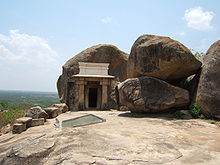
旃陀羅笈多·孔雀退休後皈依了耆那教,當時他放棄了王位和物慾,加入了一個流浪的耆那教僧侶團體。旃陀羅笈多是耆那教僧侶阿查爾亞·巴德拉巴胡的弟子。據說,在他最後的日子裡,他在卡納塔克邦的什拉瓦納貝拉戈拉執行了嚴格的自我淨化的耆那教薩萊克哈那(禁食至死)儀式。[77][76][115][75]阿育王的孫子三缽羅底也是耆那教教徒。三缽羅底受到像蘇哈斯汀這樣的耆那教僧侶的教義的影響,據說他在印度各地建造了125,000個耆那教寺廟。[116]今天在艾哈邁達巴德、維拉姆加姆、鄔闍衍那和帕利塔納等地,還能看到這些寺廟的遺存。根據一些傳說,三缽羅底和阿育王一樣,曾派信使和傳教士前往希臘、波斯和中東傳播耆那教,但迄今為止,這些傳說尚沒有被證實。[117][118]
因此,耆那教成為孔雀王朝統治下的一股重要的力量。旃陀羅笈多和三缽羅底為耆那教在印度南部的傳播起到了重要的作用。據說,在他們的統治期間建造了數十萬座寺廟和塔。
佛教
[編輯]

摩揭陀是帝國的中心,同時也是佛教的發源地。阿育王最初信奉婆羅門教,後來改信佛教;羯陵伽戰爭之後,他放棄了侵略擴張,也放鬆了《政事論》中對使用武力、強化治安、稅收徵收、打擊叛亂等嚴厲措施。阿育王派他的兒子摩哂陀和女兒僧伽蜜多率領一個使團前往斯里蘭卡,斯里蘭卡國王帝沙對佛教教義非常着迷,並將佛教定為國教。阿育王向西亞、希臘和東南亞派遣了許多佛教使團,並建造寺院和學校,大力支持佛教書籍的出版。據資料記錄,他在印度各地建造了多達84,000座佛塔,如桑吉村和摩訶菩提寺,並在阿富汗、泰國和包括西伯利亞在內的北亞地區提高了佛教的知名度。阿育王在首都附近召開了印度和南亞佛教教團的第三次集結,這次集結對佛教改革和傳播有重大影響。印度商人普遍信奉佛教,並在孔雀帝國內傳播佛教方面發揮了重要作用。[119]
社會
[編輯]孔雀王朝時期的南亞人口估計在1500到3000萬之間。[120]根據蒂姆·戴森的說法,在孔雀帝國時期,定居在恆河平原的印度-雅利安人確立了種姓制度,越來越多的部落接收了種姓制度,在印度-雅利安語地區,婦女地位也不斷下降,儘管「這些事態發展並未影響到生活在次大陸大部分地區的人們。」[121]
建築遺蹟
[編輯]
這一時期最重要的標誌性建築是在旃陀羅笈多·孔雀統治時期修建的巴塔利普特拉宮殿,遺蹟位於現在巴特那的庫姆哈爾。此地出土的宮殿遺蹟,據認為是由幾座建築組成的,其中最重要的是一座木質的屋頂的巨大的柱廊。柱子排成幾排,將柱廊劃分為許多較小的方形區域。柱子共有80根,每根高約7米。據麥加斯梯尼所見,這座宮殿主要由木材建造,比蘇薩和埃克巴坦那的宮殿更富麗堂皇,其鍍金的柱子上裝飾着金色的藤蔓和銀色的鳥兒。這些建築坐落在一個廣闊的公園裡,公園裡布滿了魚塘,還有各種各樣的觀賞性樹木和灌木。[122]考底利耶在《政事論》中,也詳述了這一時期建造宮殿的方法。現存一些石柱的碎片和一根幾乎完整的石柱,根據這些遺存,可以推斷,阿育王時代建造了這些石柱取代了早期的木柱。
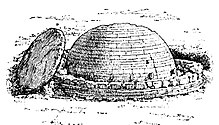
在阿育王時期,石雕藝術多種多樣,有高聳的石柱、佛塔的欄杆、石獅和巨型人物雕像。在這段時期,石雕藝術取得了非常高的成就,即使是很小的石頭碎片也達到了類似於精美琺瑯的高光澤度。這一時期同樣還是佛教建築興起的時期。阿育王建造了幾座佛塔,這些佛塔共同特點是都擁有巨大的圓頂並且帶有佛陀的雕像。The most important ones are located at Sanchi, Bharhut, Amaravati, Bodhgaya and Nagarjunakonda. The most widespread examples of Mauryan architecture are the Ashoka pillars and carved edicts of Ashoka, often exquisitely decorated, with more than 40 spread throughout the Indian subcontinent.[123][需要較佳來源]
The peacock was a dynastic symbol of Mauryans, as depicted by Ashoka's pillars at Nandangarh and Sanchi Stupa.[41]
| Maurya structures and decorations at Sanchi (3rd century BCE) | |
 Approximate reconstitution of the Great Stupa at Sanchi under the Mauryas. |
|
參考文獻
[編輯]- ^ Smith, Vincent Arthur, The Oxford History of India: From the Earliest Times to the End of 1911, Clarendon Press: 104–106, 1920
- ^ Majumdar, R. C.; Raychaudhuri, H. C.; Datta, Kalikinkar, An Advanced History of India Second, Macmillan & Company: 104, 1950
- ^ 3.0 3.1 Schwartzberg, Joseph E. A Historical Atlas of South Asia, 2nd ed. (University of Minnesota, 1992), Plate III.B.4b (p.18) and Plate XIV.1a-c (p.145)
- ^ Hermann Kulke 2004,第69-70頁.
- ^ Stein, Burton, A History of India, John Wiley & Sons: 74, 2010, ISBN 978-1-4443-2351-1,
In the past it was not uncommon for historians to conflate the vast space thus outlined with the oppressive realm described in the Arthashastra and to posit one of the earliest and certainly one of the largest totalitarian regimes in all of history. Such a picture is no longer considered believable; at present what is taken to be the realm of Ashoka is a discontinuous set of several core regions separated by very large areas occupied by relatively autonomous peoples.
- ^ Ludden, David, India and South Asia: A Short History, Oneworld Publications: 29–3, 2013, ISBN 978-1-78074-108-6,
The geography of the Mauryan Empire resembled a spider with a small dense body and long spindly legs. The highest echelons of imperial society lived in the inner circle composed of the ruler, his immediate family, other relatives, and close allies, who formed a dynastic core. Outside the core, empire travelled stringy routes dotted with armed cities. ... In most janapadas, the Mauryan Empire consisted of strategic urban sites connected loosely to vast hinterlands through lineages and local elites who were there when the Mauryas arrived and were still in control when they left.
- ^ 7.0 7.1 7.2 Coningham, Robin; Young, Ruth, The Archaeology of South Asia: From the Indus to Asoka, c.6500 BCE – 200 CE, Cambridge University Press: 451–466, 2015, ISBN 978-1-316-41898-7
- ^ Coningham, Robin; Young, Ruth, The Archaeology of South Asia: From the Indus to Asoka, c.6500 BCE – 200 CE, Cambridge University Press: 453, 2015, ISBN 978-1-316-41898-7
- ^ Dyson, Tim, A Population History of India: From the First Modern People to the Present Day, Oxford University Press: 16–17, 2018, ISBN 978-0-19-882905-8,
Magadha power came to extend over the main cities and communication routes of the Ganges basin. Then, under Chandragupta Maurya (c.321–297 bce), and subsequently Ashoka his grandson, Pataliputra became the centre of the loose-knit Mauryan 'Empire' which during Ashoka's reign (c.268–232 bce) briefly had a presence throughout the main urban centres and arteries of the subcontinent, except for the extreme south.
- ^ Nath sen, Sailendra. Ancient Indian History and Civilization. Routledge. 1999: 164.
- ^ 11.0 11.1 11.2 Bronkhorst, Johannes; Flood, Gavin. The Oxford History of Hinduism: Hindu Practice. Oxford University Press. July 2020: 68. ISBN 978-0-19-873350-8 (英語).
- ^ Omvedt, Gail. Buddhism in India: Challenging Brahmanism and Caste. SAGE Publications. 18 August 2003: 119. ISBN 978-0-7619-9664-4 (英語).
- ^ Smith, vincent A. The Oxford History Of India Part. 1-3, Ed. 4th. Oxford University Press. 1981: 99.
the only direct evidence throwing light ....is that of Jain tradition. ...it may be that he embraced Jainism towards the end of his reign. ...after much consideration I am inclined to accept the main facts as affirmed by tradition .... no alternative account exists.
- ^ Dalrymple, William. Nine Lives: In Search of the Sacred in Modern India. Bloomsbury Publishing. 2009-10-07. ISBN 978-1-4088-0341-7 (英語).
It was here, in the third century BC, that the first Emperor of India, Chandragupta Maurya, embraced the Jain religion and died through a self-imposed fast to the death,......
- ^ Keay, John. India: A History. Open Road + Grove/Atlantic. 1981: 85–86. ISBN 978-0-8021-9550-0 (英語).
- ^ 16.0 16.1 Long, Jeffery D. Historical Dictionary of Hinduism. Rowman & Littlefield. 15 April 2020: 255. ISBN 978-1-5381-2294-5 (英語).
- ^ Boyce, Mary; Grenet, F. A History of Zoroastrianism, Zoroastrianism under Macedonian and Roman Rule. BRILL. January 1991: 149. ISBN 978-90-04-29391-5 (英語).
- ^ Avari, Burjor (2007). India, the Ancient Past: A History of the Indian Sub-continent from C. 7000 BC to AD 1200 Taylor & Francis. ISBN 0415356156. pp. 188-189.
- ^ Taagepera, Rein. Size and Duration of Empires: Growth-Decline Curves, 600 B.C. to 600 A.D.. 社會科學史. 1979, 3 (3/4): 132. JSTOR 1170959. doi:10.2307/1170959.
- ^ Turchin, Peter; Adams, Jonathan M.; Hall, Thomas D. East-West Orientation of Historical Empires. Journal of World-Systems Research. December 2006, 12 (2): 223 [16 September 2016]. ISSN 1076-156X. (原始內容存檔於20 May 2019).
- ^ 21.0 21.1 Dyson, Tim, A Population History of India: From the First Modern People to the Present Day, Oxford University Press: 16–17, 2018, ISBN 978-0-19-882905-8 Quote: "Magadha power came to extend over the main cities and communication routes of the Ganges basin. Then, under Chandragupta Maurya (c.321–297 bce), and subsequently Ashoka his grandson, Pataliputra became the centre of the Mauryan 'Empire' which during Ashoka's reign (c.268–232 bce) had a presence throughout the main urban centres and arteries of the entire subcontinent, except for the extreme southern end."
- ^ Ludden, David, India and South Asia: A Short History, Oneworld Publications: 29–30, 2013, ISBN 978-1-78074-108-6 |quote=The geography of the Mauryan Empire resembled a spider with a small dense body and long spindly legs. The highest echelons of imperial society lived in the inner circle composed of the ruler, his immediate family, other relatives, and close allies, who formed a dynastic core. Outside the core, empire travelled stringy routes dotted with armed cities. Outside the palace, in the capital cities, the highest ranks in the imperial elite were held by military commanders whose active loyalty and success in war determined imperial fortunes. Wherever these men failed or rebelled, dynastic power crumbled. ... Imperial society flourished where elites mingled; they were its backbone, its strength was theirs. Kautilya's Arthasastra indicates that imperial power was concentrated in its original heartland, in old Magadha, where key institutions seem to have survived for about seven hundred years, down to the age of the Guptas. Here, Mauryan officials ruled local society, but not elsewhere. In provincial towns and cities, officials formed a top layer of royalty; under them, old conquered royal families were not removed, but rather subordinated. In most janapadas, the Mauryan Empire consisted of strategic urban sites connected loosely to vast hinterlands through lineages and local elites who were there when the Mauryas arrived and were still in control when they left.
- ^ Hermann Kulke 2004,第xii, 448頁.
- ^ Thapar, Romila. A History of India, Volume 1. Penguin Books. 1990: 384. ISBN 0-14-013835-8.
- ^ Keay, John. India: A History. Grove Press. 2000: 82. ISBN 978-0-8021-3797-5.
- ^ 26.0 26.1 R. K. Mookerji 1966,第31頁.
- ^ Seleucus I ceded the territories of Arachosia (modern Kandahar), Gedrosia (modern Balochistan), and Paropamisadae (or Gandhara). Aria (modern Herat) "has been wrongly included in the list of ceded satrapies by some scholars ... on the basis of wrong assessments of the passage of Strabo ... and a statement by Pliny" (Raychaudhuri & Mukherjee 1996, p. 594).
- ^ John D Grainger 2014,第109頁: Seleucus "must ... have held Aria", and furthermore, his "son Antiochos was active there fifteen years later".
- ^ Bhandari, Shirin. Dinner on the Grand Trunk Road. Roads & Kingdoms. 2016-01-05 [2016-07-19] (美國英語).
- ^ Hermann Kulke 2004,第67頁.
- ^ Dyson, Tim, A Population History of India: From the First Modern People to the Present Day, Oxford University Press: 24, 2018, ISBN 978-0-19-882905-8 Quote: "Yet Sumit Guha considers that 20 million is an upper limit. This is because the demographic growth experienced in core areas is likely to have been less than that experienced in areas that were more lightly settled in the early historic period. The position taken here is that the population in Mauryan times (320–220 BCE) was between 15 and 30 million—although it may have been a little more, or it may have been a little less."
- ^ Ludden, David, India and South Asia: A Short History, Oneworld Publications: 28–29, 2013, ISBN 978-1-78074-108-6Quote: "A creative explosion in all the arts was a most remarkable feature of this ancient transformation, a permanent cultural legacy. Mauryan territory was created in its day by awesome armies and dreadful war, but future generations would cherish its beautiful pillars, inscriptions, coins, sculptures, buildings, ceremonies, and texts, particularly later Buddhist writers."
- ^ Dyson, Tim, A Population History of India: From the First Modern People to the Present Day, Oxford University Press: 19, 2018, ISBN 978-0-19-882905-8 Quote: "Accordingly, as tribal societies were encountered by the expanding Indo-Aryan societies, so the evolving caste system provided a framework within which—invariably at a low level—tribal people could be placed. For example, by the time of the Mauryan Empire (c.320–230 bce) the caste system was quite well established and the Aranyachará (i.e. forest people) were grouped with the most despised castes. ... The evolution of Indo-Aryan society in the centuries before c.200 bce not only saw increased segregation with respect to caste, it also seems to have seen increased differentiation with respect to gender. ... Therefore, by the time of the Mauryan Empire the position of women in mainstream Indo-Aryan society seems to have deteriorated. Customs such as child marriage and dowry were becoming entrenched; and a young women's purpose in life was to provide sons for the male lineage into which she married. To quote the Arthashāstra: 'wives are there for having sons'. Practices such as female infanticide and the neglect of young girls were possibly also developing at this time, especially among higher caste people. Further, due to the increasingly hierarchical nature of the society, marriage was possibly becoming an even more crucial institution for childbearing and the formalization of relationships between groups. In turn, this may have contributed to the growth of increasingly instrumental attitudes towards women and girls (who moved home at marriage). It is important to note that, in all likelihood, these developments did not affect people living in large parts of the subcontinent—such as those in the south, and tribal communities inhabiting the forested hill and plateau areas of central and eastern India. That said, these deleterious features have continued to blight Indo-Aryan speaking areas of the subcontinent until the present day."
- ^ "It is doubtful if, in its present shape, [the Arthashastra] is as old as the time of the first Maurya", as it probably contains layers of text ranging from Maurya times till as late as the 2nd century CE. Nonetheless, "though a comparatively late work, it may be used ... to confirm and supplement the information gleaned from earlier sources". (Raychaudhuri & Mukherjee 1996, pp. 246–247)
- ^ 35.0 35.1 35.2 35.3 35.4 Irfan Habib & Vivekanand Jha 2004,第14頁.
- ^ 36.0 36.1 Singh, Upinder. A History of Ancient and Early Medieval India: From the Stone Age to the 12th Century. Pearson Education India. 2008. ISBN 9788131716779 (英語).
- ^ Annual Report Of Mysore 1886 To 1903.
- ^ Epigraphia Indica Vol.20. Achaeological Survey of India. 1920: 80 (英語).
- ^ D·C·薩卡爾. The Satavahanas and the Chedis. R·C·馬宗達 (編). The Age of Imperial Unity. Bharatiya Vidya Bhavan. 1968: 215.
- ^ R. K. Mookerji 1966,第14頁.
- ^ 41.0 41.1 R. K. Mookerji 1966,第15頁.
- ^ H. C. Raychaudhuri 1988,第140頁.
- ^ R. K. Mookerji 1966,第8頁.
- ^ Sugandhi, Namita Sanjay. Between the Patterns of History: Rethinking Mauryan Imperial Interaction in the Southern Deccan. 2008: 88–89. ISBN 9780549744412.
- ^ Kosmin 2014,第31頁.
- ^ Nath sen, Sailendra. Ancient Indian History and Civilization. Routledge. 1999: 162. ISBN 9788122411980.
- ^ Nath sen, Sailendra. Ancient Indian History and Civilization. Routledge. 1999: 130. ISBN 9788122411980.
- ^ :"Androcottus, when he was a stripling, saw Alexander himself, and we are told that he often said in later times that Alexander narrowly missed making himself master of the country, since its king was hated and despised on account of his baseness and low birth." Plutarch 62-3 Plutarch 62-3
- ^ :"He was of humble Indian to a change of rule." Justin XV.4.15 "Fuit hic humili quidem genere natus, sed ad regni potestatem maiestate numinis inpulsus. Quippe cum procacitate sua Nandrum regem offendisset, interfici a rege iussus salutem pedum ceieritate quaesierat. (Ex qua fatigatione cum somno captus iaceret, leo ingentis formae ad dormientem accessit sudoremque profluentem lingua ei detersit expergefactumque blande reliquit. Hoc prodigio primum ad spem regni inpulsus) contractis latronibus Indos ad nouitatem regni sollicitauit." Justin XV.4.15 網際網路檔案館的存檔,存檔日期1 February 2016.
- ^ Hermann Kulke 2004,第69–70頁.
- ^ Thapar 2013,第362–364頁.
- ^ 52.0 52.1 Sen 1895,第26–32頁.
- ^ Upinder Singh 2008,第272頁.
- ^ Mookerji 1988,第28–33頁.
- ^ Hemacandra 1998,第175–188頁.
- ^ Mookerji 1988,第33頁.
- ^ Malalasekera 2002,第383頁.
- ^ Mookerji 1988,第33-34頁.
- ^ Trautmann 1971,第43頁.
- ^ Chandragupta Maurya and His Times, Radhakumud Mookerji, Motilal Banarsidass Publ., 1966, p.26-27 Mookerji, Radhakumud. Chandragupta Maurya and His Times. 1966 [2016-11-26]. ISBN 9788120804050. (原始內容存檔於27 November 2016).
- ^ Mookerji 1988,第34頁.
- ^ Roy 2012,第62頁.
- ^ 63.0 63.1 From Polis to Empire, the Ancient World, C. 800 B.C.-A.D. 500. Greenwood Publishing. 2002 [16 August 2019]. ISBN 0313309426.
- ^ Kistler, John M. War Elephants. University of Nebraska Press. 2007: 67 [16 August 2019]. ISBN 978-0803260047.
- ^ s, deepak. Indian civilization. deepak shinde. 2016-10-25 (英語).
- ^ Kosmin 2014,第38頁.
- ^ Arrian. Book 5. Anabasis.
Megasthenes lived with Sibyrtius, satrap of Arachosia, and often speaks of his visiting Sandracottus, the king of the Indians.
- ^ "In the royal residences in India where the greatest of the kings of that country live, there are so many objects for admiration that neither Memnon's city of Susa with all its extravagance, nor the magnificence of Ectabana is to be compared with them. ... In the parks, tame peacocks and pheasants are kept." Aelian, Characteristics of animals book XIII, Chapter 18, also quoted in The Cambridge History of India, Volume 1, p411
- ^ Romila Thapar (1961), Aśoka and the decline of the Mauryas, Volume 5, p.129, Oxford University Press. "The architectural closeness of certain buildings in Achaemenid Iran and Mauryan India have raised much comment. The royal palace at Pataliputra is the most striking example and has been compared with the palaces at Susa, Ecbatana, and Persepolis."
- ^ 70.0 70.1 70.2 Upinder Singh 2008,第331頁.
- ^ Kosmin 2014,第32頁.
- ^ Chatterjee, Suhas. Indian Civilization and Culture. M.D. Publications. 1998. ISBN 9788175330832 (英語).
- ^ Dikshitar, V. R. Ramachandra. The Mauryan Polity. Motilal Banarsidass. 1993. ISBN 9788120810235 (英語).
- ^ R. K. Mookerji 1966,第39–40頁.
- ^ 75.0 75.1 Geoffrey Samuel 2010,第60頁.
- ^ 76.0 76.1 Romila Thapar 2004,第178頁.
- ^ 77.0 77.1 R. K. Mookerji 1966,第39–41頁.
- ^ Srinivasachariar 1974,第lxxxvii頁.
- ^ Vincent Arthur Smith. Asoka, the Buddhist emperor of India. Oxford: Clarendon Press. 1920: 18–19. ISBN 9788120613034.
- ^ Rajendralal Mitra. On the Early Life of Asoka. Proceedings of the Asiatic Society of Bengal (Asiatic Society of Bengal). 1878: 10.
- ^ Motilal Banarsidass. The Minister Cāṇakya, from the Pariśiṣtaparvan of Hemacandra. 菲莉絲·格蘭諾夫 (編). The Clever Adulteress and Other Stories: A Treasury of Jaina Literature. 由Rosalind Lefeber翻譯. 1993: 204–206. ISBN 9788120811508.
- ^ Kosmin 2014,第35頁.
- ^ Alain Daniélou 2003,第108頁.
- ^ Dineschandra Sircar 1971,第167頁.
- ^ William Woodthorpe Tarn. The Greeks in Bactria and India. Cambridge University Press. 2010: 152. ISBN 9781108009416.
- ^ Mookerji Radhakumud. Asoka. Motilal Banarsidass. 1962: 8. ISBN 978-81-208-0582-8. (原始內容存檔於10 May 2018).
- ^ 87.0 87.1 Alain Daniélou 2003,第109頁.
- ^ Eugène Burnouf. Legends of Indian Buddhism. New York: E. P. Dutton. 1911: 59.
- ^ 89.0 89.1 89.2 89.3 S. N. Sen 1999,第142頁.
- ^ "Three Greek ambassadors are known by name: Megasthenes, ambassador to Chandragupta; Deimachus, ambassador to Chandragupta's son Bindusara; and Dyonisius, whom Ptolemy Philadelphus sent to the court of Ashoka, Bindusara's son", McEvilley, p.367
- ^ India, the Ancient Past, Burjor Avari, pp. 108–109
- ^ Arthur Llewellyn Basham, History and doctrines of the Ājīvikas: a vanished Indian religion, pp. 138, 146
- ^ Anukul Chandra Banerjee, Buddhism in comparative light, p. 24
- ^ Beni Madhab Barua, Ishwar Nath Topa, Ashoka and his inscriptions, Volume 1, p. 171
- ^ Kashi Nath Upadhyaya. Early Buddhism and the Bhagavadgita. Motilal Banarsidass. 1997: 33. ISBN 9788120808805.
- ^ 菲茨傑拉德·霍爾 (編). The Vishnu Purana IV. 由H·H·威爾遜翻譯. Trübner & Co. 1868: 188.
- ^ Allchin, F. R.; Erdosy, George. The Archaeology of Early Historic South Asia: The Emergence of Cities and States. Cambridge: Cambridge University Press. 1995: 306.
- ^ Edicts of Ashoka, 13th Rock Edict, translation S. Dhammika.
- ^ Thapar, Romila. Aśoka and the Decline of the Mauryas. Oxford Scholarship Online. 2012. ISBN 9780198077244. doi:10.1093/acprof:oso/9780198077244.003.0031.
- ^ Singh 2012,第131, 143頁.
- ^ According to the Ashokavadana
- ^ Sir John Marshall (1990), "A Guide to Sanchi", Eastern Book House, ISBN 81-85204-32-2, p. 38
- ^ E. Lamotte, History of Indian Buddhism, Institut Orientaliste, Louvain-la-Neuve 1988 (1958)
- ^ Romila Thapar (1960), Aśoka and the Decline of the Mauryas, Oxford University Press, p. 200
- ^ Kangle, R. P. A Study. Motilal Banarsidass Publ. 1986. ISBN 978-81-208-0041-0 (英語).
- ^ Nath sen, Sailendra. Ancient Indian History and Civilization. Routledge. 1999: 160. ISBN 9788122411980.
- ^ Gabriel A, Richard. The Ancient World :Volume 1 of Soldiers' lives through history. Greenwood Publishing Group. 30 November 2006: 28. ISBN 9780313333484.
- ^ R. C. Majumdar 2003,第107頁.
- ^ Kulke, Herman. History of India. Routledge. 2004: 79. ISBN 9780415329200.
- ^ Indian History. Allied Publishers. 1988. ISBN 9788184245684 (英語).
- ^ Narain Singh Kalota. India As Described By Megasthenes. 1978.
- ^ The Economic History of the Corporate Form in Ancient India. 網際網路檔案館的存檔,存檔日期4 February 2016. University of Michigan.
- ^ CNG Coins 網際網路檔案館的存檔,存檔日期27 August 2017.
- ^ Nath sen, Sailendra. Ancient Indian History and Civilization. Routledge. 1999: 164. ISBN 9788122411980.
- ^ Hermann Kulke 2004,第64-65頁.
- ^ John Cort 2010,第142頁.
- ^ John Cort 2010,第199頁.
- ^ Tukol, T. K. Jainism in South India. (原始內容存檔於4 March 2016).
- ^ Jerry Bentley, Old World Encounters: Cross-Cultural Contacts in Pre-Modern Times (New York: Oxford University Press), 46
- ^ Dyson, Tim, A Population History of India: From the First Modern People to the Present Day, Oxford University Press: 24, 2018, ISBN 978-0-19-882905-8 Quote: "Yet Sumit Guha considers that 20 million is an upper limit. This is because the demographic growth experienced in core areas is likely to have been less than that experienced in areas that were more lightly settled in the early historic period. The position taken here is that the population in Mauryan times (320–220 bce) was between 15 and 30 million—although it may have been a little more, or it may have been a little less."
- ^ Dyson, Tim, A Population History of India: From the First Modern People to the Present Day, Oxford University Press: 19, 2018, ISBN 978-0-19-882905-8 Quote: "... there seems to have been an interplay between the developing system of caste on the one hand, and the increased frequency with which 'tribal' societies were confronted on the other. In this context, castes and tribes can be seen as being broadly analogous-esepcially in that they tend to marry endogenously and maintain their own collective identities.62 Accordingly, as tribal societies were encountered by the expanding Indo-Aryan societies, so the evolving caste system provided a framework within which—invariably at a low level—tribal people could be placed. For example, by the time of the Mauryan Empire (c.320–230 bce) the caste system was quite well established and the Aranyachará (i.e. forest people) were grouped with the most despised castes [...] The evolution of Indo-Aryan society in the centuries before c.200 bce not only saw increased segregation with respect to caste, it also seems to have seen increased differentiation with respect to gender ... Therefore, by the time of the Mauryan Empire the position of women in mainstream Indo-Aryan society seems to have deteriorated. Customs such as child marriage and dowry were becoming entrenched; and a young women's purpose in life was to provide sons for the male lineage into which she married. To quote the Arthashāstra: 'wives are there for having sons'. Practices such as female infanticide and the neglect of young girls were possibly also developing at this time, especially among higher caste people. Further, due to the increasingly hierarchical nature of the society, marriage was possibly becoming an even more crucial institution for childbearing and the formalization of relationships between groups. In turn, this may have contributed to the growth of increasingly instrumental attitudes towards women and girls (who moved home at marriage). It is important to note that, in all likelihood, these developments did not affect people living in large parts of the subcontinent—such as those in the south, and tribal communities inhabiting the forested hill and plateau areas of central and eastern India. That said, these deleterious features have continued to blight Indo-Aryan speaking areas of the subcontinent until the present day."
- ^ "L'age d'or de l'Inde Classique", p23
- ^ "L'age d'or de l'Inde Classique", p22
- ^ Described in Marshall p.25-28 Ashoka pillar.



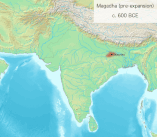



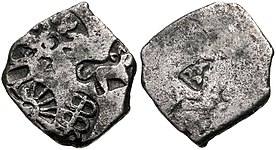

![孔雀帝國硬幣(舍利輸迦皇帝時期,大約公元前207-公元前194年)[113]](http://upload.wikimedia.org/wikipedia/commons/thumb/9/98/Mauryan_Empire._temp._Salisuka_or_later._Circa_207-194_BC.jpg/310px-Mauryan_Empire._temp._Salisuka_or_later._Circa_207-194_BC.jpg)
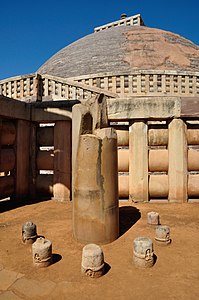

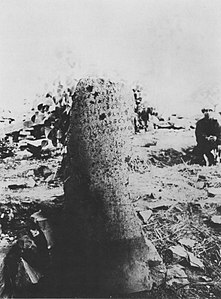
![The capital nowadays.[124]](http://upload.wikimedia.org/wikipedia/commons/thumb/f/f5/Sanchi_capital_right_side_view.jpg/181px-Sanchi_capital_right_side_view.jpg)